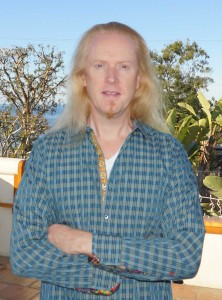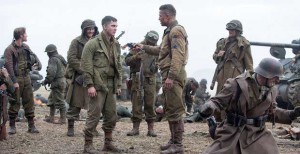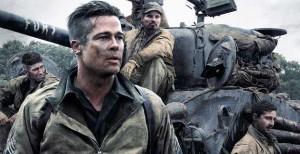
To present as authentic a war zone as possible, the filmmakers behind Fury got up close and personal with some of World War II’s most dangerous machines. For three-time Oscar winner and the film’s supervising sound editor, re-recording mixer and sound designer Paul Ottosson (Zero Dark Thirty, The Hurt Locker), this included being amongst the first team of sound professionals to record the sound of a German Tiger-1 tank for cinema as well as an American Sherman tank. “In a movie like this, you don’t get the ‘wow’ factor by trying to create a really cool sound. You get it by recording the actual sound the machines would make. Then, it’s how you build it and mix it to get a big ‘wow’ moment in the movie,” shared Ottosson.
From director David Ayer, Fury stars Brad Pitt, Shia LaBeouf, Logan Lerman, Michael Pena and Jon Bernthal as the crew of a Sherman tank, tasked with reaching and defending a cross-roads in the middle of enemy country. Bonded to their tank, dubbed Fury, the soldiers risk everything to keep it running and fighting long enough to complete their mission.
Edited on Avid‘s Pro Tools, Fury‘s soundscape carefully conveys a total presence of war. According to Ottosson, delivering an honest mix devoid of unnecessary flare was his primary objective. “You want the audience to feel like they are in the war without being impressed by any individual elements, just the whole experience.” A major influence for understanding what would make the soundscape honest was Ottosson’s personal history as a soldier. “Though I hadn’t been in WWII or any other war, I knew that sound was really important because very seldom do you see your enemy. They’re usually far enough away shooting at you, or hiding somewhere, so I think it was important to hear what is all around you. To identify what weapon is shooting at you and from where.”

Part of providing the soundscape of war included acknowledging the distant battles heard by a crew. “There’s not a single spot in the whole movie that is just quiet. There are planes flying by, there’s artillery, explosions all around, there is war going on almost the entire movie.” Ottosson explained that the Fury crew was just one small group in a much larger war. Because of this, building in a background of distant battles helped serve authenticity and story. “The key then is to find its place without killing the dialogue. You can’t just turn sound effects on and off around the dialogue. That would sound really artificial. The trick to that is: where there’s no dialogue, you get this bigger dynamic texture. As dialogue starts, you weed out mid-range texture but still maintain low-end explosions, rather than drop things out. It’s important to maintain the audience in this relentless war the entire time.”
An additional mechanism of presenting the war as experienced by tank-men was the presence of radio communication. “There is communication going on tank to tank to make sure everybody’s on the same page,” explained Ottosson. “There’s also communication going on from the battles over the next hill. It was a lot of work to fit that in the mix and maintain this off-screen war the whole time, while we need to hear all dialogue on the screen.” Ottosson explained the priority of hearing dialogue over all other sounds. “The film was written with people talking to each other, and that is how a lot of the story is told. I think you have to be respectful of dialogue in any movie and make sure it is always heard.” According to Ottosson, Ayer wrote a twenty-page script of just off-screen radio communication, accurate to real locations and battles of the time. Using radio communication as sound-bed and primary dialogue was not only a tool to serve authenticity, but one for critical story beat and emotion. “In all scenes when we hear the radios we know there’s a way to communicate. Then, when they’re in the battle with the Tiger, the radio goes dead. Now, they are left on this mission with no way to communicate. It was important to establish this lifeline and be able to take it away.”
 Due to the operating of actual WWII tanks, both picture and sound departments benefited from the construction of tank-interior replicas. “For all of the exteriors, when you see a tank, it was a real tank driving. For most of the interiors, it was a rebuild of the tank that was open so you could get all the camera angles.” For sound, the tank replicas were equally crucial. Capturing dialogue while inside a moving Sherman would have been impossible due to its incredibly loud engine.
Due to the operating of actual WWII tanks, both picture and sound departments benefited from the construction of tank-interior replicas. “For all of the exteriors, when you see a tank, it was a real tank driving. For most of the interiors, it was a rebuild of the tank that was open so you could get all the camera angles.” For sound, the tank replicas were equally crucial. Capturing dialogue while inside a moving Sherman would have been impossible due to its incredibly loud engine.
Blending sound design with music was another challenging mix. Using a scene wherein tanks and soldiers push across a battlefield toward enemy fire, Ottosson described the balancing act. “We played up all the big tanks and heavy engines, roaring in and tearing down the trees. When the music starts, I peel out of all those tanks. For the entire battle, there are no tank engines, but as an audience, I don’t think you hear that. We set you up with big tanks but then hand it off to the music. We only play up the key sound moments for the tanks, to leave room for dialogue and such.”
“German weapons and American weapons didn’t sound the same,” said Ottosson. “The German army was a very refined army. They had the best of the best of weapons. They had machine guns, such as the MG42 you see in the movie, which shot about a thousand rounds a minute, and there was nothing else like that at the time.” Research and hands-on recording of WWII artillery helped Ottosson to properly present the weapons of Fury. Most specifically, the high-velocity German artillery took priority in respect to weapons work. Ottosson learned that the barrels of the high velocity machine guns would overheat, forcing the Germans to change barrels frequently. This informed the soundscape when building battle sequences. “When we’re cutting them into the movie, we don’t have these guns shooting for 20 seconds at a time. The Germans wouldn’t have shot them that way. They would have shot in bursts. That is the fun of doing a movie like this. You learn so much about how these wars would have been fought.”
The Tiger 1 tanks had such high velocity canons, the shells easily pierced the armor of the Sherman tanks. According to Ottosson, WWII veterans have described the sound of high-velocity shells in such detail, he and his team worked carefully to build each shell’s sonic character. “When those shells came in, they were described by soldiers from WWII as piercing, like a freight train flying by.” Regarding story, Ottosson added, “For Wardaddy [Pitt], he had been in this war for so long, he knew what was going on around him. It was important to identify the sound of the high-velocity shells and from which direction they were coming. If it was a high-velocity shell coming at you, one hit and you were done. If it was a normal shell whizzing by, you knew that you could take a good handful of hits to the tank. Once Wardaddy hears the high pitched, high-velocity guns, they’re all thinking ‘holy crap.'”
For the sound design of high-velocity shell fire, Ottosson and team recorded live ammunition and a collection of materials including brass and steel. “When you fire those shells, to get a longer sound, which is most useful, you have to fire them higher up in the air,” explained Ottosson. “Higher up in the air, in the proximity of where you are, the shell doesn’t travel passed you as fast. In the movie, we show shells whizzing by ten feet above ground. If you record a real shell that close to it, you don’t get enough. For the sake of the high-velocity shells, I created something to emulate what they would experience out there. The solution ended up being a frisbee. I attached whistles to it, and if I threw it you’d have this screaming, whistling sound flying by. I could also control how hard I wanted to throw it, and could get close to record it without getting killed doing it. It gave me a much longer head and tail of the sound.” As sound and picture came together in the cutting room, Ottosson discovered the true value of the frisbee creation. “This sound bridged all the cuts to maintain the horror of these Shells flying by. It was a bit funny because we have this really dark movie, with nothing but death in it, and the sound of what everyone feared most – these high-velocity guns – ended up being a kid’s toy, the frisbee, with a handful of whistles.”
“When the shells hit the tank, they would hit with such incredible force it would make the whole tank ring and vibrate. It would be like you were sitting inside a big church bell.” Actual brass church bells were used to capture some of the sound that comprises the impact of high-velocity shell and tank. Additionally, brass polls were hit together to simulate a round bouncing off of a Sherman. The team also fired and recorded 50-caliber machine guns to create the hammering of gunfire experienced by War Daddy and the Fury crew. Ottosson and sound recordist Eilam Hoffman operated the tanks and recorded their engines. Charles Maynes and Charlie Campagna ran point on weapons recordings.
Production recordings were made even more believable when mixed against picture by simulating the Doppler effect. Ottosson used equalizers and pitch manipulators to create the traveling sonic character of flying shells. “I’d record a sound that was long enough for me, then I’d manipulate it afterwards with EQ and volume, to get it to feel like it’s spinning,” explained Ottosson. “There are some programs out there that create the Doppler effect for you, but I find they become a little bit mechanical. It does the same thing over and over. When you do it by hand, it’s always different. It’s not perfect. I like imperfection in sound. Maybe that’s old-school, but I like the results of crafting sound by hand.”
According to Ottosson, Ayer’s diligence in research and personal history in the military informed the accuracy of Fury. “He shot a lot of film… He’s a guy that doesn’t give up until he has what he wants.” Ayer assisted in foley capture by providing the team with actual WWII artifacts to record. “He arranged for us to have the real gear the SS soldiers would wear. Everything was the real deal. From the tiniest things, like their canteens, to the most important things. The real deal.”
Ottosson’s background as a musician is an additional influence on his approach to sound editing. For him, some scenes require editing without looking at picture, allowing emotion, pace, rhythm and tone to take priority. “A lot of times, what I enjoy in a good sound design is the flow and pacing of the sounds. A lot of times I would cut not necessarily in sync with picture, but in a way that would feel right with the rhythm,” explained Ottosson. “I played in a band before, and sometimes you would practice and no one played anything wrong. You just nailed the song. Every single note was correct, but it didn’t feel right. Sometimes, we would play and there might have been one or two notes that weren’t exactly perfect, but everyone in the band felt it. That’s what I’m looking for in a scene. That it does something to you.”
Regarding Fury and editing for emotion, Ottosson singled out Wardaddy’s hand gun. Ottosson explained the gun sounds less intense when he fires it personally than when he forces Norman (Lerman) to fire it. In one of the film’s early scenes, Wardaddy provides Norman an introduction to the life of war by way of initiation. Creating a bigger sound for the gun when fired by Norman into the back of a Nazi soldier served the brutal subtext of the pivotal scene. “It’s not just paint by color, you see a gun you put in a gun. There’s more to it than that.”





